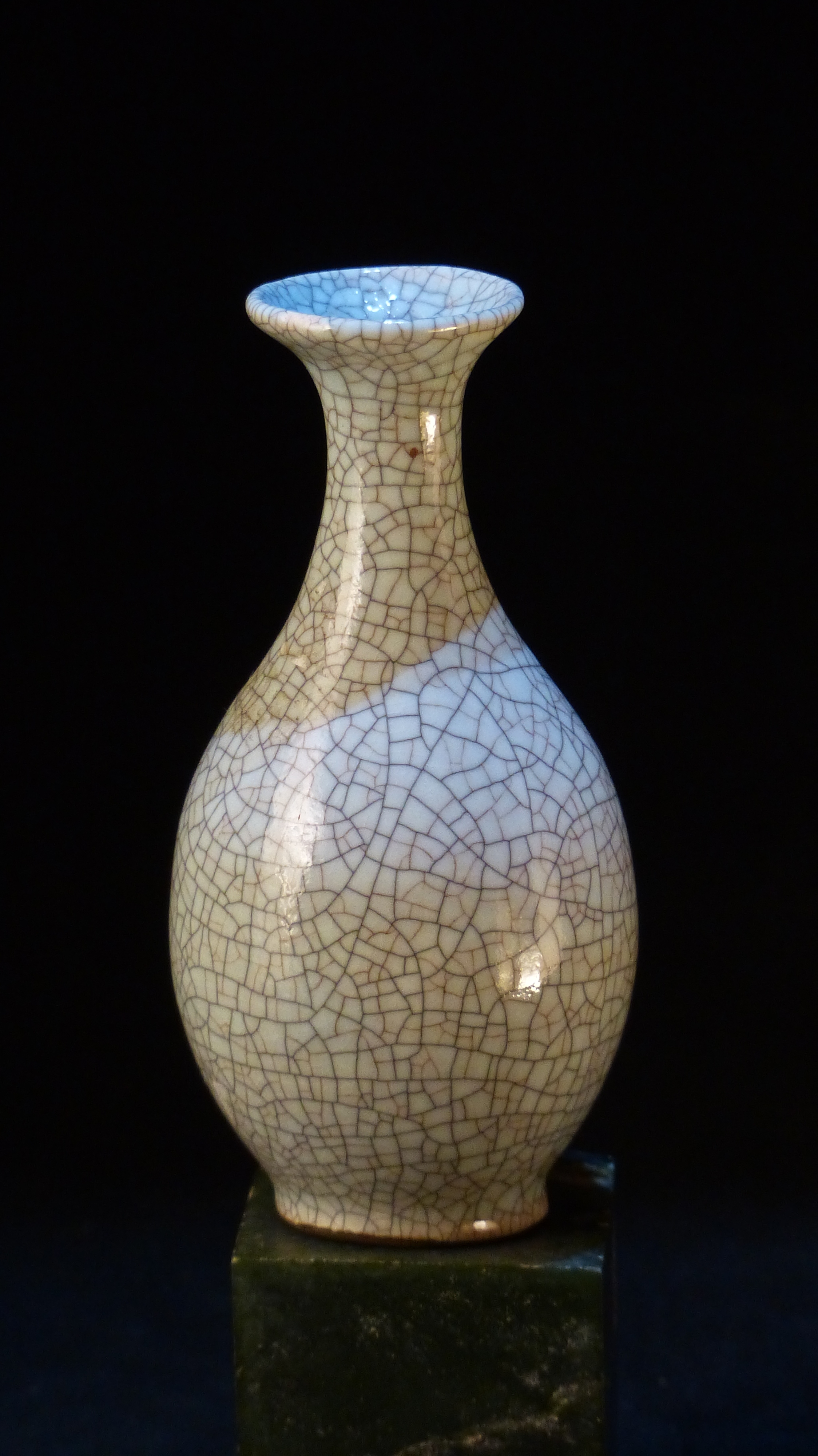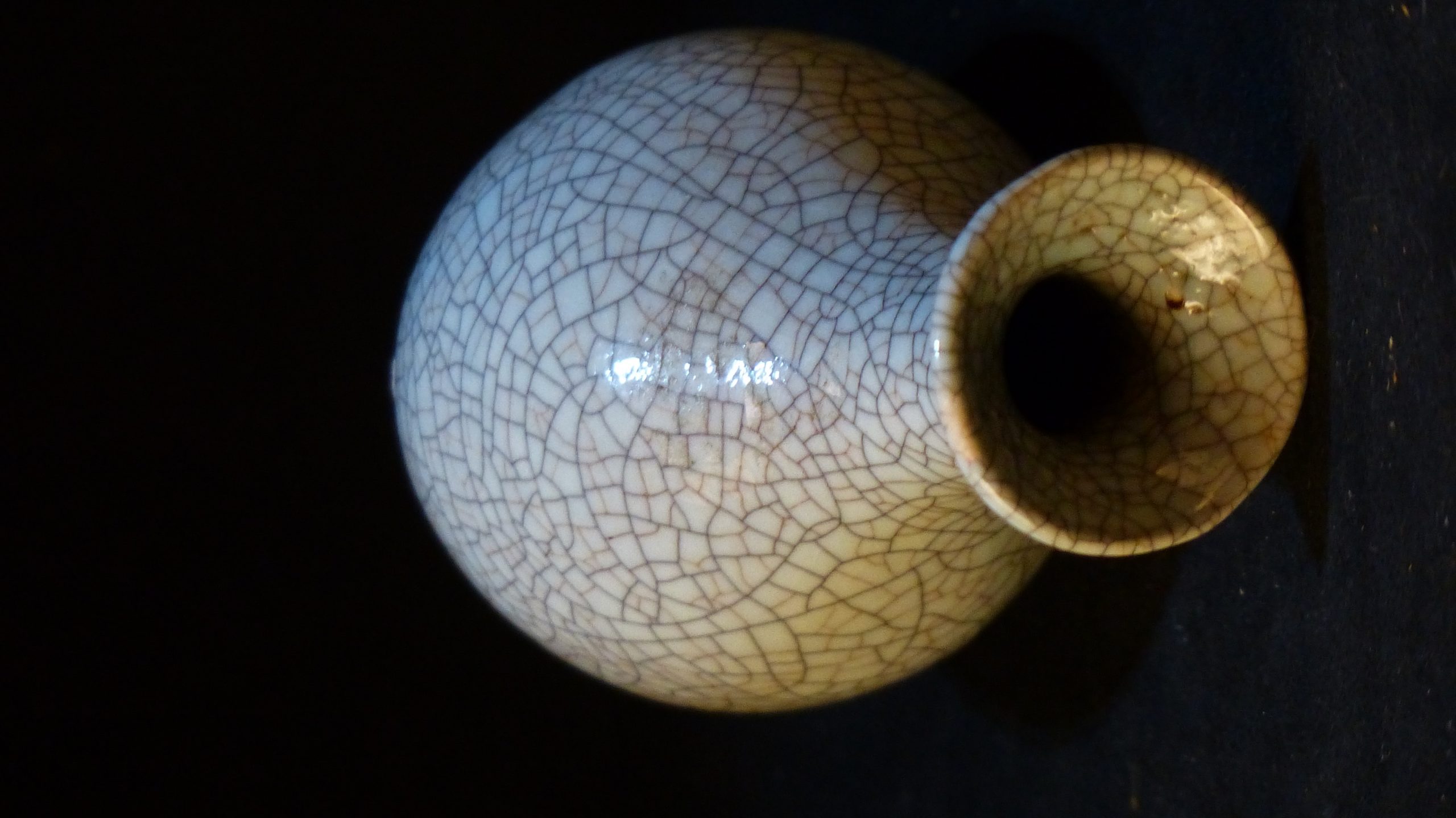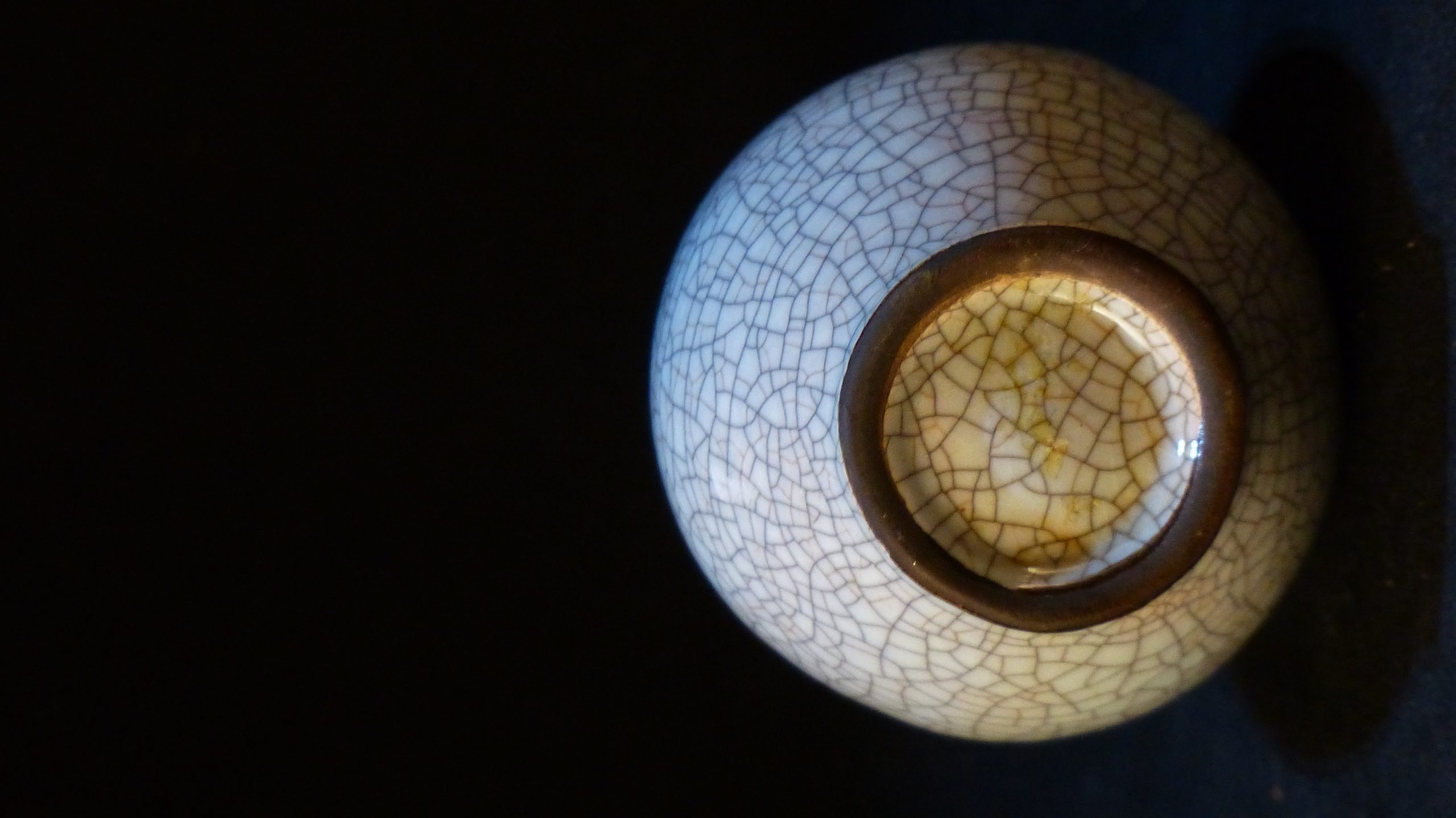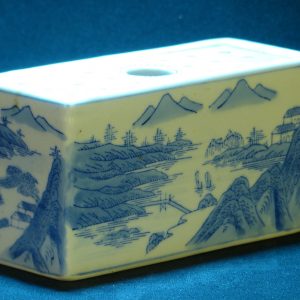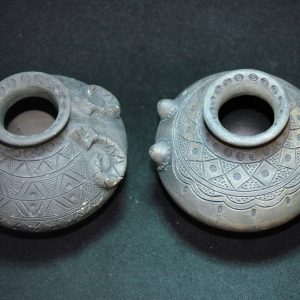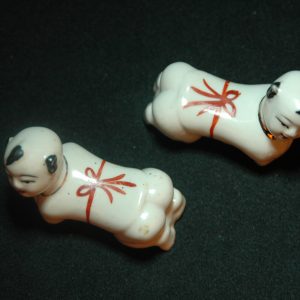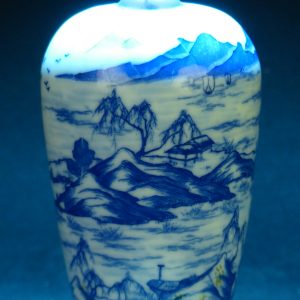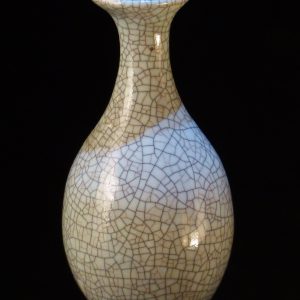Description
哥窑观音瓶
参考: 大英博物馆藏原大维德基金会中国宋元青瓷选粹-哥窑瓷
Percival David Foundation of Chinese Art,中译珀西瓦尔·大维德中国艺术基金会,即今为人所熟知的大维德基金会。由大维德爵士起头,联合伦敦大学创建,1952年6月10日正式面向公众开放,地址位于布鲁姆伯利区(Bloomsbury)的乔顿广场(Gordon Square)53号楼。直到2007年,大维德基金会因为财政问题关闭,这栋小楼都是世界各地的中国学者或艺术爱好者的朝圣之地。基金会关闭后,这一批无与伦比的艺术珍品,其去向成为问题,后经由何鸿卿爵士的倡议与慷慨解囊下,最终由大英博物馆整体接收,并于2009年,在新建的95号厅中永久性展出。
大维德爵士生于1892年的印度孟买。其父亲为萨森·大维德爵士一世(Sir Sassoon Jacob David)是印度银行的创始人之一,经营一家业务庞大的贸易公司。少年富裕的家庭与其出身,极大的开拓了他的眼界,他曾就读于额尔芬斯东学院,后又于孟买大学于剑桥大学就读。1926年,大维德的父亲去世,于是继承了乃父的爵位,并接手家族生意,成为公司主席。
大维德爵士的收藏时代正处于清王朝的崩溃时代,混乱的中国政治局势为其收藏打开了大门。据称他的收藏情缘始自于朋友家壁炉上陈设的一只中国花瓶,由此,大维德爵士开始了他一生曲折而辉煌的收藏道路。1923年的大维德已经在收藏界内小有名气,1924年,大维德应邀来到中国,并协助举办1925年的清宫珍宝展览,展览取得了巨大的成功。这使得他成为第一批深入紫禁城的外国收藏家之一,也从此明确了他的收藏方向。
1927年,大维德爵士再次回到中国,并在这次回国的阶段,取得了界碑性的成就:将传说中1901年慈禧太后出宫避乱时,抵押给盐业银行的一批清宫秘宝中四十余件极珍贵的瓷器收入囊中,其中变包括大名鼎鼎的汝窑宫碗。这是他正式成长为系统性中国陶瓷收藏家的重要一步。
1929年,大维德爵士回到伦敦,旋即重返中国,并在1930~1931年之间,参加、协助、组织了众多清室遗珍展览。在此期间,通过周旋于多方渠道,终于获得了丰硕成果。蒐集到了数目巨大,并蔚为系统的中国陶瓷珍品,从战国时代的原始青瓷到民国时期的摹古产品,可谓逐项涵盖。
20世纪三十年代中,应国民政府的邀请,大维德爵士受英国政府的指定,联合组织大英博物馆的霍布逊(R.L.Hobson)与著名收藏家乔治·尤莫夫泊洛斯(George Eumorfopoulos)和奥斯卡·拉斐尔(Oscar Raphael)、伦敦大学的叶兹教授(W.P.Yetts)五人组成了英方的大展五人组委会,与北京故宫方面的马衡院长等联合。这一大展是为了彼时之中英外交,庆祝英王登基而所立,其政治性质之重、展览规格之高、展品挑选之精、展会要求之严,诸等方面,都是空前绝后,史不曾有的。其中近八成的展品来自于北京故宫博物院,并联合诸欧洲藏家的私人珍藏。该展会在1935年~1936年的国际上取得了极大的成功,是开创性的,里程碑式的一次展会。是次展览沸腾了整个西方世界,使中国文化辉煌的展现在了西方世人的面前。
大维德爵士亦是促成世界上第一个中国艺术与考古系建立的主要人物。他还翻译了明人曹昭的《格古要论》一书,开创性的以文献方式,向西方世界介绍了中国传统文人的物质文化。他于1935年在伦敦苏富比举办的,英国收藏家查尔斯·E·罗素(Charles E.Russell)藏品的拍卖中购得了一件元青花龙纹象耳大瓶,并后与来自于蒙斯图沃德· 埃尔芬斯通(Mountstuart Elphinstone)的另外一只合璧为一对,成为元青花研究史上最为重要的一套纪年标准器,开启了元青花研究中的“至正类型”。此外,在1952年,基金会正式开放前夕,还接收到了来自埃尔芬斯通的一批捐赠,其中大多数是单色釉瓷器,这使得大维德基金会的构成更加丰富完满。
1941年的大维德爵士,因为“珍珠港事件”的影响,在中国被日本人逮捕,于上海关押达九个月之久。关押期间,大维德爵士患上了肌肉萎缩症,并最终因为此病,在1964年10月9号去世。曾被哈瑞·戛纳爵士(Sir Harry Mason Garner)称为“我们这个时代最伟大的中国艺术鉴赏收藏家”的一代收藏伟人,就此陨落。
2007年,大维德基金会因为无法解决的财政问题而关闭,在此之前,一直堪称是世界范围内收藏中国瓷器最为系统的一个机构之一。其中包涵了大量的宋元青瓷珍品。是次我社精选数十件宋元时期的青瓷,按其系统,并分数辑,力求珍稀、趣味与艺术,加之编号、尺寸数据等,整合在此,以飨读者。
本期共选二十件宋元时期的官哥类型珍品,并有十一件馆方所定“明清时期”的官哥类型瓷器附录于后。因其官哥类型青瓷问题的复杂性与特殊性,其年代、窑口的诸多判断现今仍是迷雾重重,诸家观点亦多有分歧。故遵照传统,谨以大英博物馆的官方意见为标注,是表尊敬,特此声明。
向大维德爵士致以崇高的敬意。

馆藏编号:PDF.91
尺寸:高 12cm;腹径7.6cm
北京保利2019春季拍卖会 >中国古董珍玩Ⅰ
5752 清 青釉贯耳投壶

青釉贯耳投壶
拍品信息
LOT号 5752
作品名称 清 青釉贯耳投壶
作者 —
尺寸 高31cm
创作年代 清
估价 3,000-5,000
成交价 RMB 4,600
参考:苏富比 541
中國藝術品 包括趙從衍家族收藏藝術珍品
明 官系膽瓶

90,000 — 120,000港幣
拍品已售 112,500 港幣 成交價 (含買家佣金)
拍品詳情
明 官系膽瓶
11.5 公分,4 1/2 英寸
中國藝術品 包括趙從衍家族收藏藝術珍品
2017年11月30日 – 2017年12月1日 | 下午 2:00 HKT
香港
参考:佳士得 拍賣 3371
重要中國瓷器及工藝精品
Hong Kong, HKCEC Grand Hall|2014年11月26日
拍品3234 明 哥釉小瓶
|PROPERTY FROM THE YIQINGGE COLLECTION
A FINE AND RARE SMALL GE BOTTLE VASE
MING DYNASTY (1368-1644)
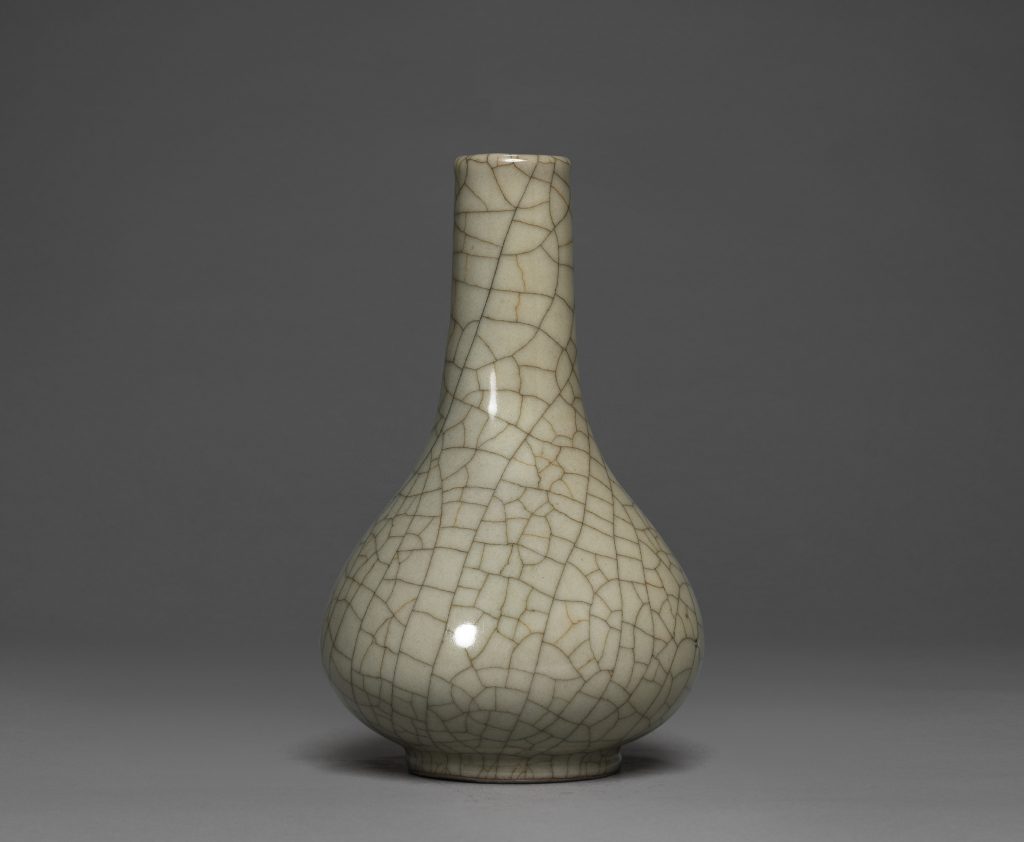
成交總額
HKD 1,180,000
估價
HKD 400,000 – HKD 500,000
A FINE AND RARE SMALL GE BOTTLE VASE
MING DYNASTY (1368-1644)
The vase is well potted with a compressed body raised on a short cylindrical foot ring and tapers to a long neck terminating in a small slightly lipped mouth.
5 1/2 in. (14 cm.) high, Japanese wood box
参考:佳士得拍賣 3323
漱玉供菊 – 宋代藝術精品
香港|2014年5月28日
拍品3210 宋 哥釉瓶
A VERY RARE SMALL GE BOTTLE VASE
SONG DYNASTY (960-1279) OR LATER
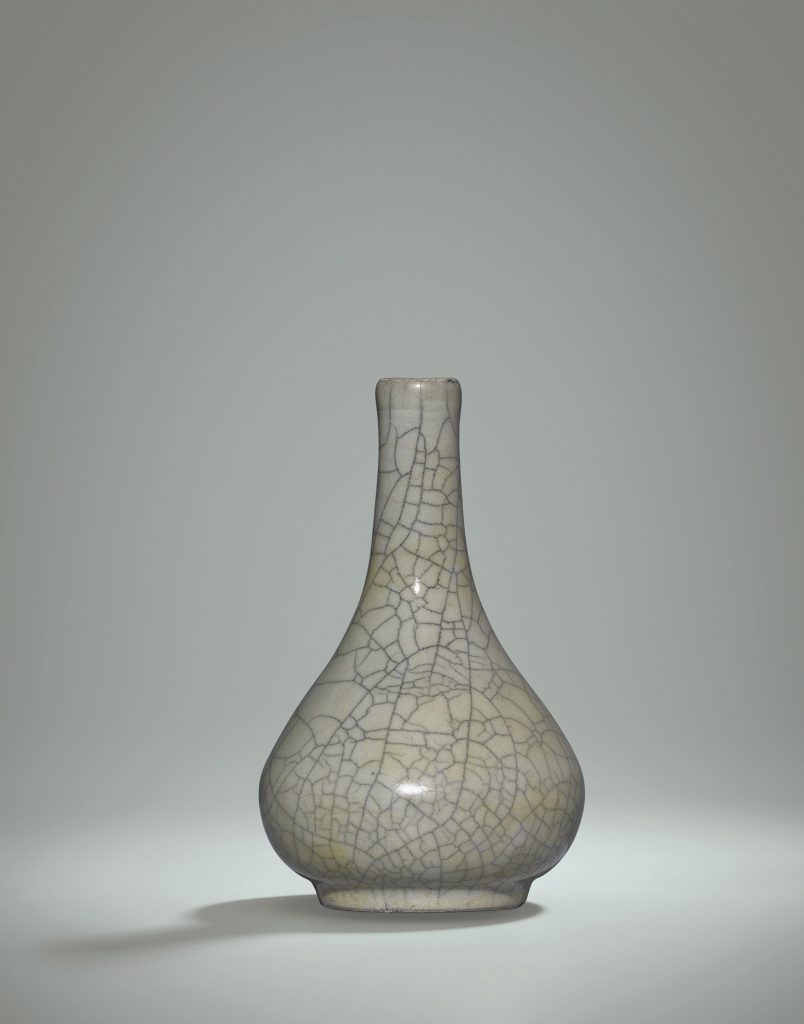
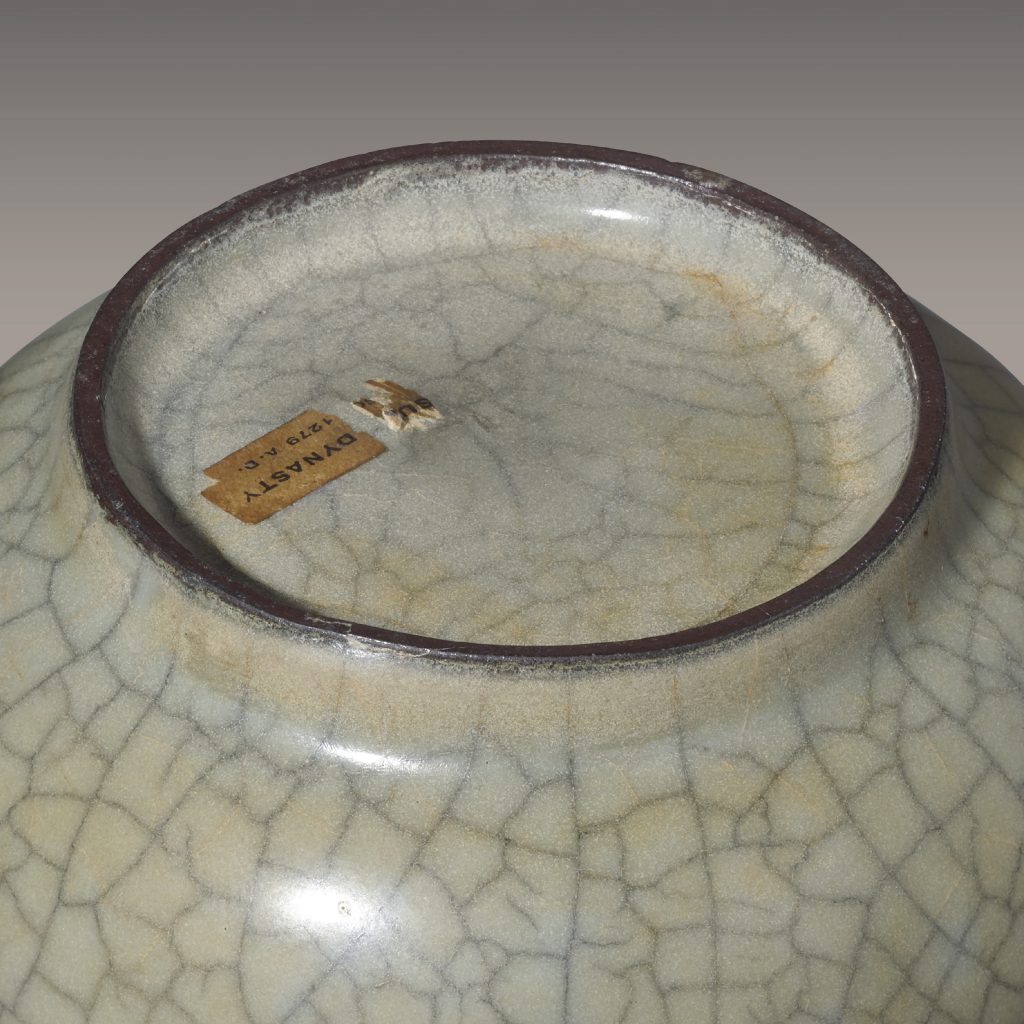
成交總額
HKD 4,240,000
估價
HKD 400,000 – HKD 600,000
A VERY RARE SMALL GE BOTTLE VASE
SONG DYNASTY (960-1279) OR LATER
The vase is well-potted with a compressed bulbous body raised on a short cylindrical foot ring and tapers to a long neck terminating in a small slightly lipped mouth. It is covered with a thick cream-coloured glaze with a spiralling network of black crackles underlaid with finer golden-brown crackles.
5 3/4 in. (14.5 cm.) high
拍品專文
Two similar vases in the Palace Museum, Beijing, have been published, the first of very similar size (14.2 cm. high) and proportions, illustrated in Song Dynasty (III), The Complete Collection of Treasures of the Palace Museum, Hong Kong, 1996, no. 35; and the second, slightly smaller in size (13.8 cm. high) with a narrower lower body, ibid, no. 36. Another closely related example, similar in proportions to the second Palace Museum example, was included in the exhibition catalogue Possessing the Past: Treasures from the National Palace Museum, New York, 1996, pl. 123.
参考: 佳士得 拍賣 15488
中國瓷器及工藝精品
倫敦|2018年11月6日
拍品149
明 仿官釉八棱葵瓣洗
MING DYNASTY (1368-1644)
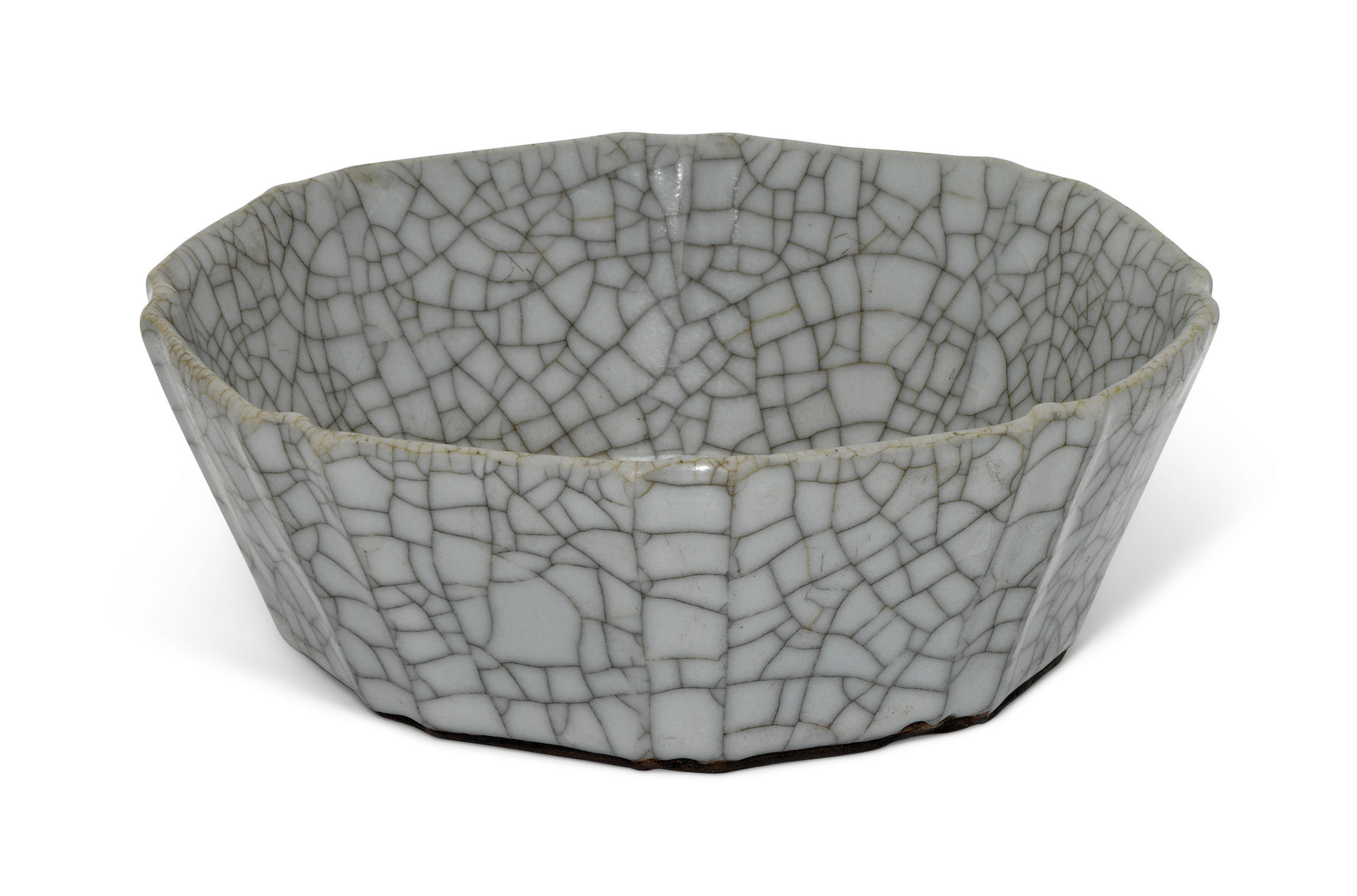
明 仿官釉八棱葵瓣洗
成交總額
GBP 16,250
估價
GBP 8,000 – GBP 12,000
明 仿官釉八棱葵瓣洗
5 ¾ in. (14.5 cm.) diam.
参考:佳士得拍賣 3433
中國宮廷御製藝術精品
重要中國瓷器及工藝精品
Hong Kong, HKCEC Grand Hall|2015年6月3日
拍品3248
清乾隆 仿哥釉貫耳方壺 六字篆書款
QIANLONG SIX-CHARACTER SEAL MARK IN UNDERGLAZE BLUE AND OF THE PERIOD (1736-1795)
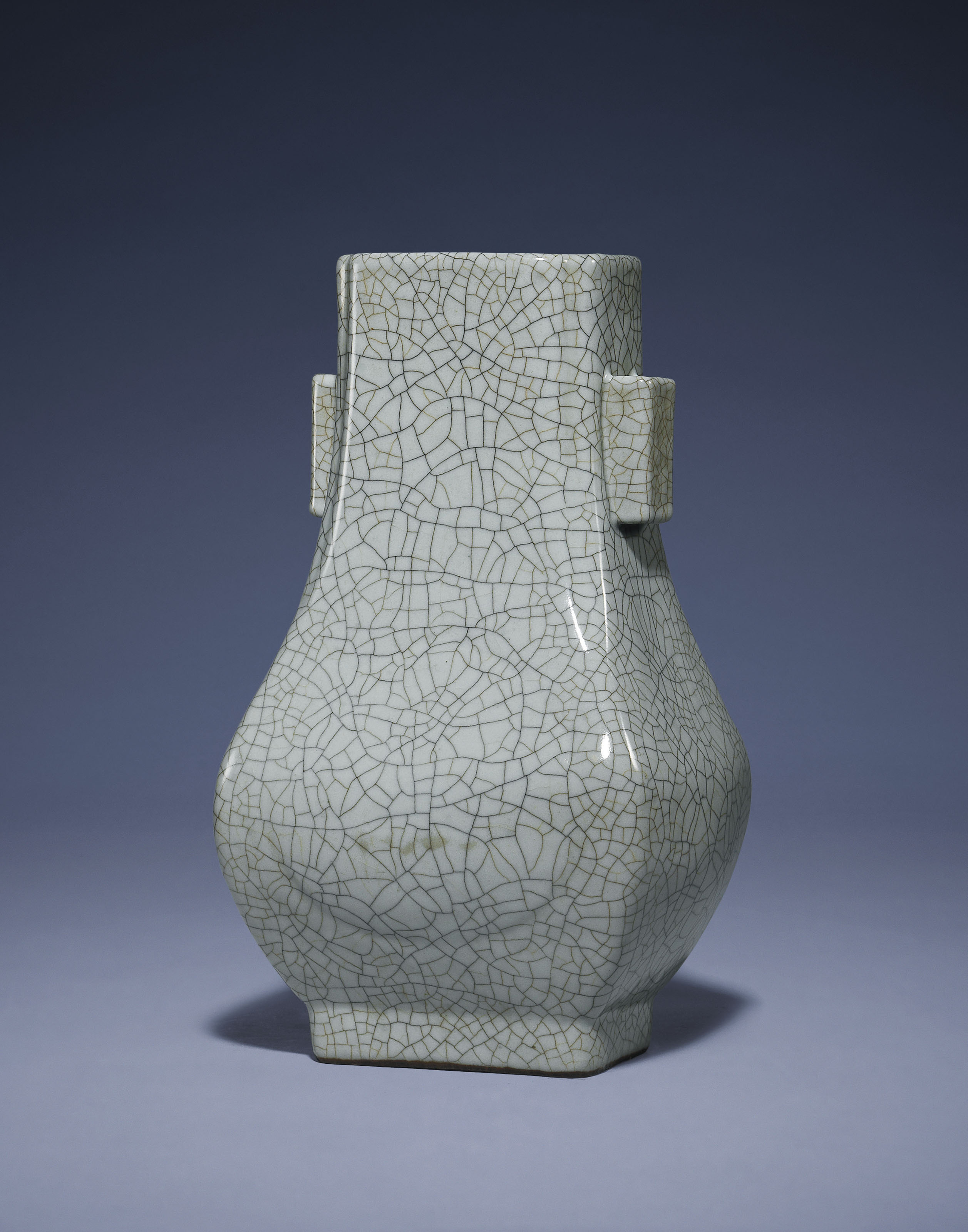
清乾隆 仿哥釉貫耳方壺 六字篆書款
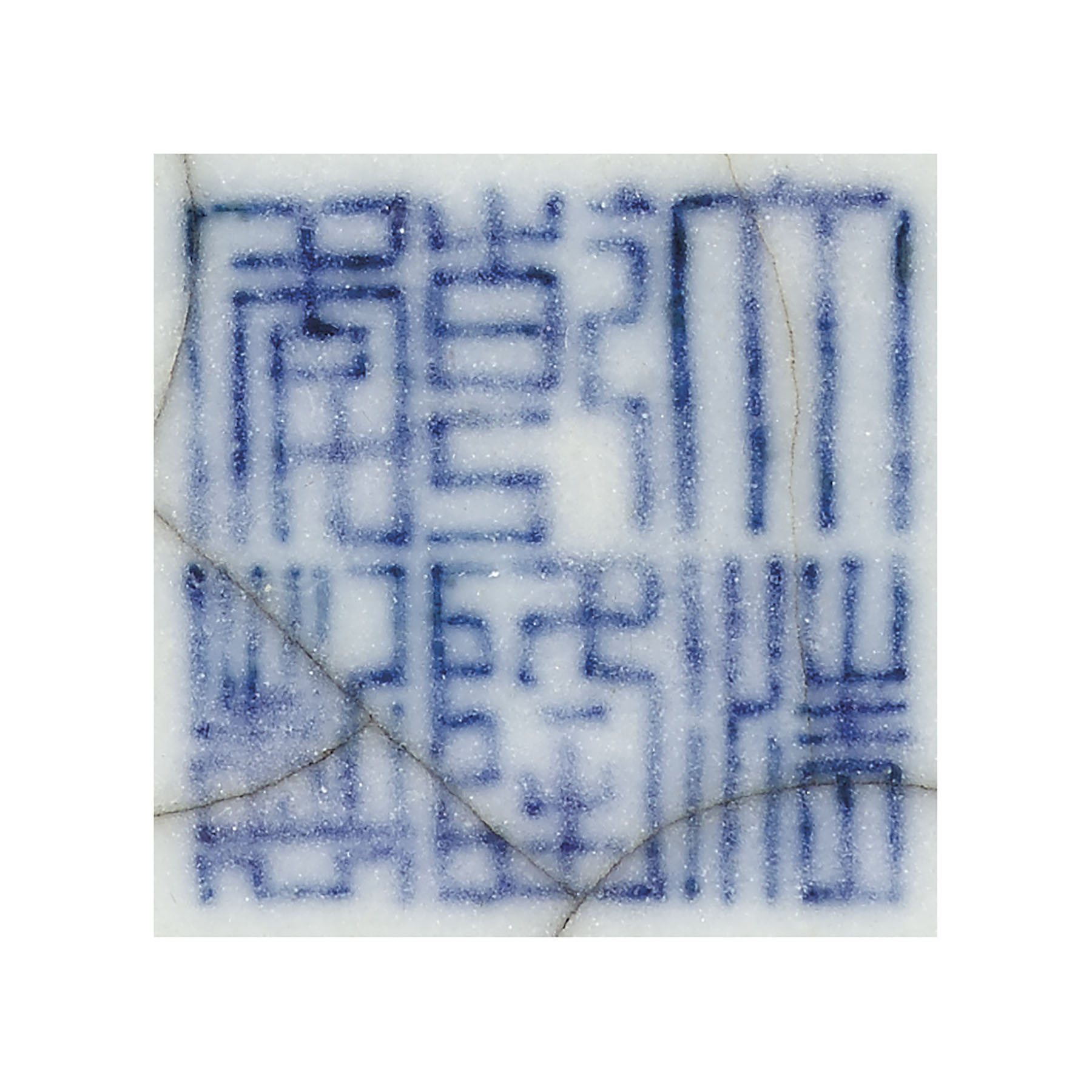
清乾隆 仿哥釉貫耳方壺 六字篆書款
成交總額
HKD 750,000
估價
HKD 500,000 – HKD 700,000
清乾隆 仿哥釉貫耳方壺
六字篆書款
來源
日本近衛家族珍藏(據傳) 日本京都土橋嘉兵衛珍藏 日本京都私人收藏,入藏於1950 年代
拍品專文
Archaism as a major theme in the crafts of the Qing dynasty, is represented two-fold on the present lot. The fanghu shape is derived from early bronze wares of the Shang and Zhou dynasties, while the glaze is an imitation of the Southern Song dynasty Ge glaze. Compare the present vase with its Song prototype, a small Guan vase with canted corners in the Freer Gallery of Art, Washington D.C., illustrated in Oriental Ceramics, Kodansha Series, Japan, 1981, vol. 9, Japan, 1987, no. 960; and another sold at Christie’s Hong Kong, 30 May 2005, lot 1513.
Compare also to a Qianlong fanghu-shaped Ge-type vase, illustrated in Chinese Ceramics in the Idemitsu Collection, Japan, 1987, no. 960.
編製圖錄及詳情
拍賣現場通告
Please note the provenance of this lot should read:
Konoe Family, by repute
Mr. Kahe Tsuchihashi, Kyoto
A Japanese private collection, Kyoto, since the 1950s
参考:佳士得拍賣 3406
古今 ∣ 佳士得:中國瓷器及工藝精品
22nd Floor|2015年4月6日
拍品208|ANOTHER PROPERTY
清雍正 仿哥釉菊瓣瓶 六字篆書款
YONGZHENG SIX-CHARACTER SEAL MARK IN UNDERGLAZE BLUE AND OF THE PERIOD (1723-1735)
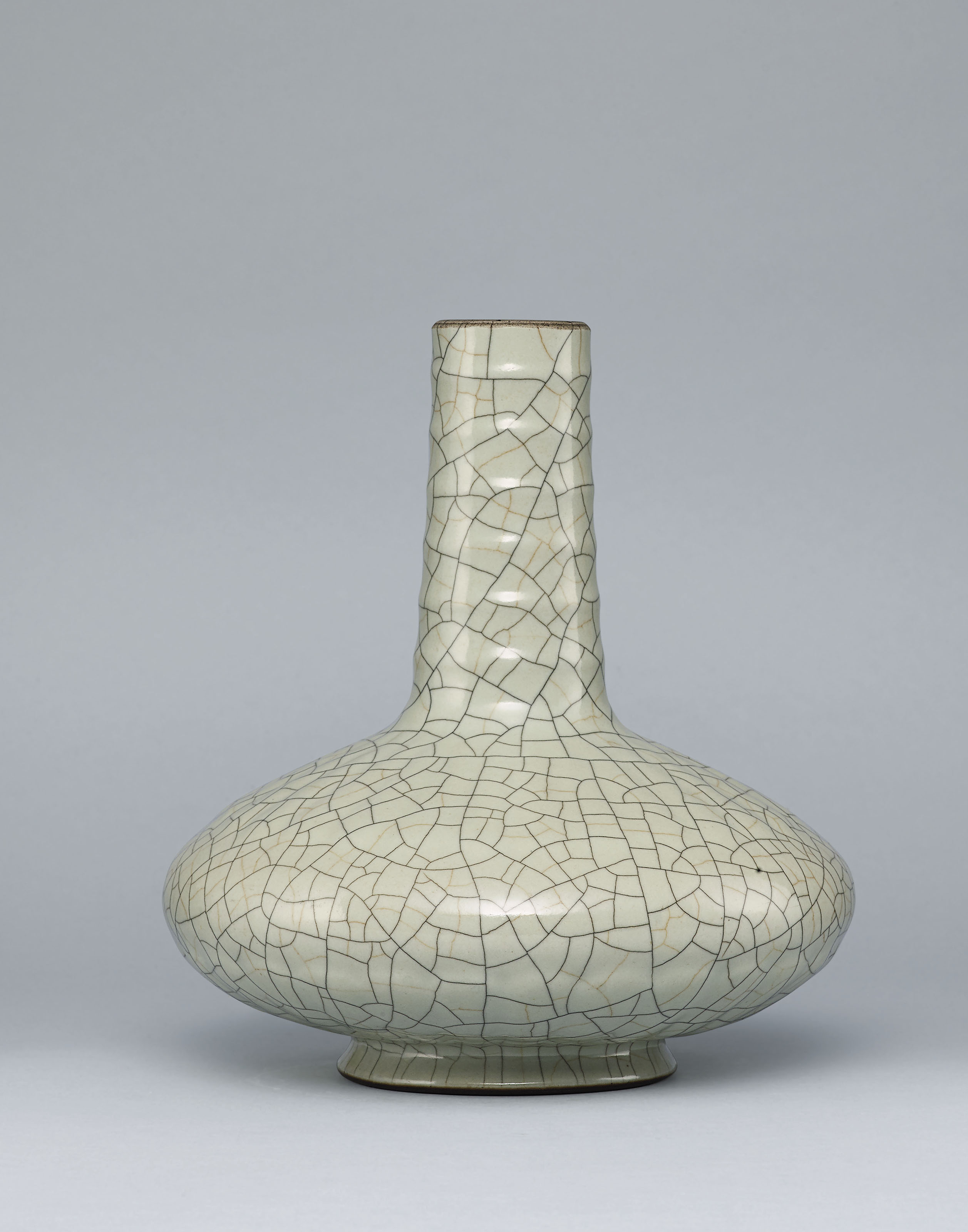
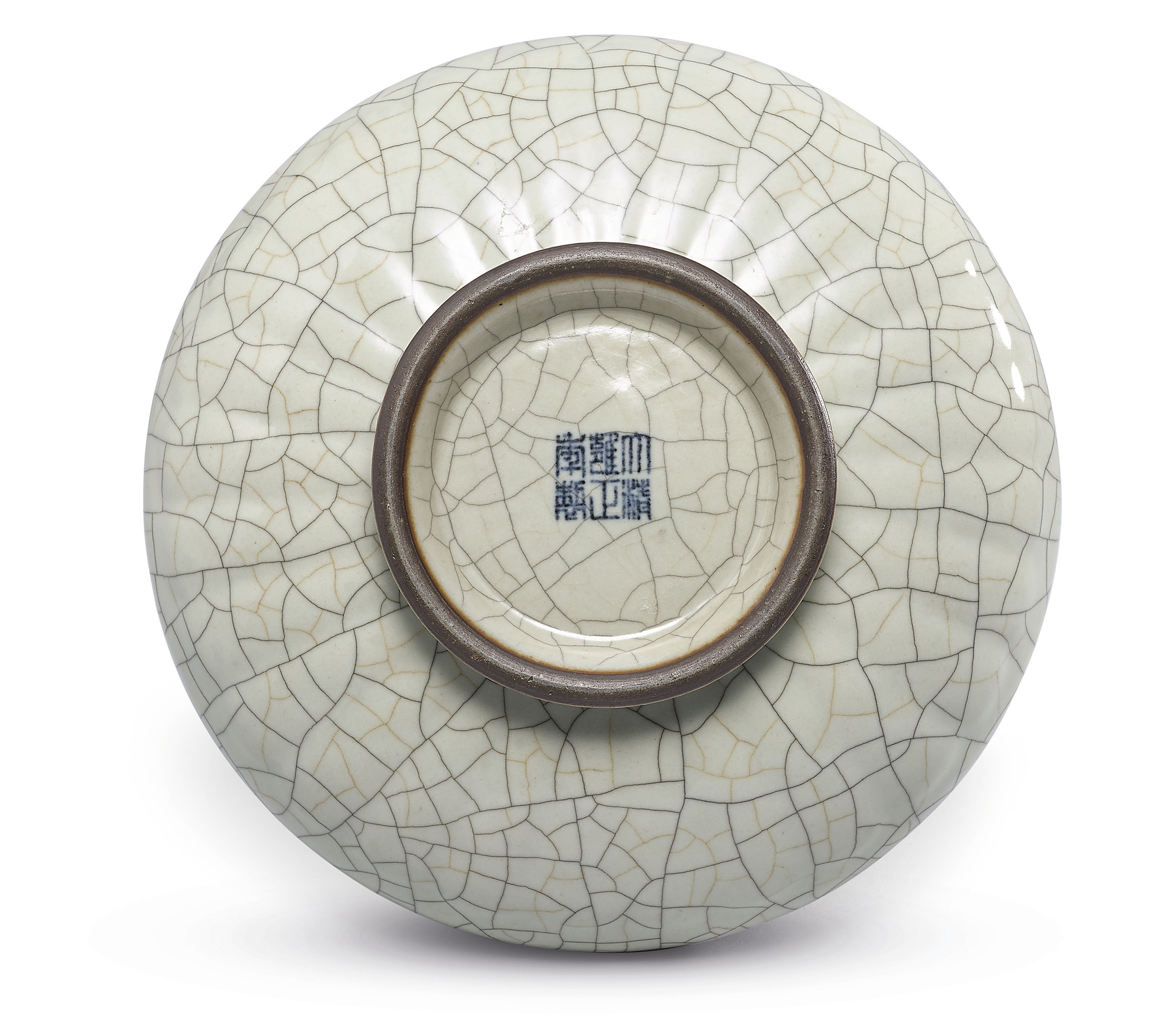
成交總額
HKD 1,120,000
估價
HKD 1,000,000 – HKD 1,500,000
清雍正 仿哥釉菊瓣瓶 六字篆書款
來源
紐約佳士得,2008 年3 月19 日,拍品645 號
参考:佳士得拍賣 3720
重要中國瓷器及工藝精品
紐約|2015年3月15日 – 16日
拍品3243|PROPERTY FROM A DISTINGUISHED PRIVATE COLLECTION
南宋/元 哥窯水丞
SOUTHERN SONG-YUAN DYNASTY (1127-1368)
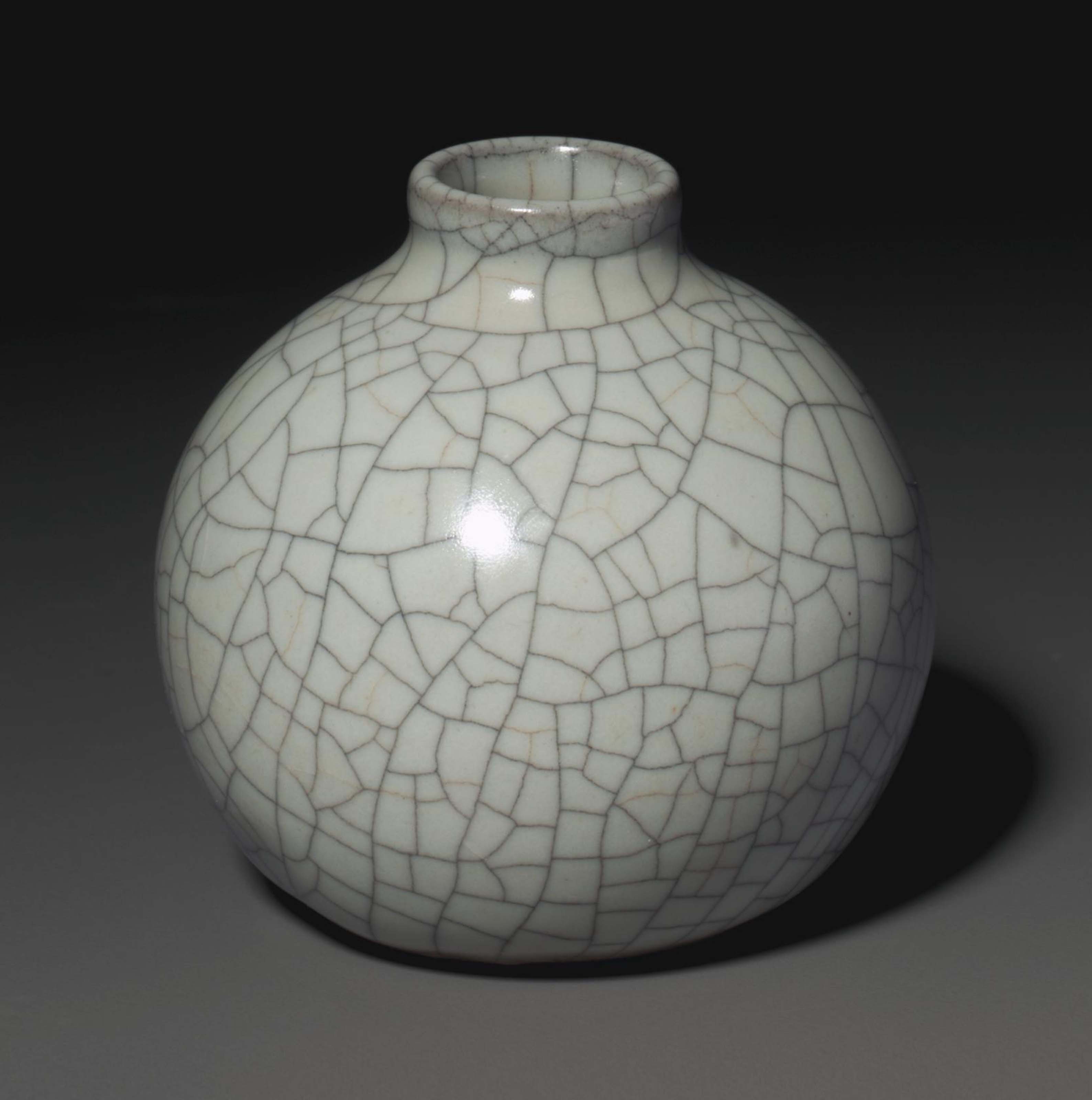
成交總額
USD 1,085,000
估價
USD 1,000,000 – USD 1,500,000
南宋/元 哥窯水丞
來源
Christie’s Hong Kong, 1 November 2004, lot 802.
文獻及展覽
文獻
Christie’s 20 Years in Hong Kong, 1986 – 2006, Chinese Ceramics and Works of Art Highlights, p. 31.
拍品專文
This water pot has an exceptionally well-potted spherical form. Small compressed globular water pots with celadon glazes were made in Zhejiang province as early as the Southern Dynasties period (AD 420-589). One such vessel, excavated from a 5th century tomb in Yongjia county and now in the Wenzhou Museum, is illustrated in Complete Collection of Ceramic Art Unearthed in China, vol. 9, Zhejiang, Beijing, 2008, p. 87. Similar compressed globular water pots, with or without three small feet, were also made at the Ou kilns and the Yue ware kilns in the Tang dynasty. Examples from the Wenzhou Museum and the Cixi Museum are illustrated ibid, pp. 126 and 127 respectively. However, in the Five Dynasties period well-potted spherical water pots can be found amongst vessels from prestigious kilns which found favour with the imperial court. A mise celadon water pot of this spherical form, and of very similar size to the current Ge ware vessel, was excavated in Lin’an county in 1996 from the Kangling Mausoleum (dated AD 939), illustrated ibid., p. 143. A fine 10th-century spherical white-glazed water pot with incised lotus decoration, slightly smaller than the current Ge ware vessel, is in the collection of the Tokyo National Museum. This white water pot, which is illustrated in Sekai toji zenshu, vol. 11, Sui Tang, Tokyo, 1976, pp. 115-6, pls. 92-3, is inscribed on the base with the characters xin guan (new official). Although the Tokyo water pot has no neck or raised mouth rim, a small Ding ware spherical water pot (7.5 cm high) with a very short neck was excavated in 1969 from the foundations of the Jingzhongyuan Temple pagoda, dated AD 995, illustrated by the Idemitsu Museum of Arts in Treasures from the Underground Palaces – Excavated Treasures from Northern Song Pagodas, Dingzhou, Hebei Province, China, Tokyo, 1997, no. 90. A larger spherical Ding ware water pot with longer neck and thickened rim, also from Jingzhongyuan Temple pagoda, is illustrated by Liu Tao in Song Liao Jin jinian ciqi, Beijing, 2004, p. 5, fig. 1-29. Thus, by the early Northern Song dynasty, late 10th century, the spherical form for small water pots was already established as desirable amongst the Chinese elite.
A Guan-type water pot of similar size to the current vessel, with a spherical body, but standing on three short, splayed legs, is illustrated in Mayuyama Seventy Years, vol. 1, Tokyo, 1976, p. 161, no. 467. A Guan or Ge ware spherical water pot, also of similar size to the current vessel, was sold by Christie’s Hong Kong on 13 January 1987, lot 570. A water pot with Guan-type glaze, of slightly smaller size compared to the current vessel, and of compressed globular form, is illustrated in Chinese Ceramics, Song and Yuan Dynasty, Taipei, 1988, p. 515. A slightly larger 13th century spherical celadon-glazed water pot from the Longquan kilns, with floral surface decoration, is in the collection of Sir Percival David (illustrated in Illustrated Catalogue of Celadon Wares in the Percival David Foundation of Chinese Art, revised edition, 1997, pp. 29-30, no. 232), and was exhibited in Arts de la Chine Ancienne at the Musée de l’Orangerie, Paris, in 1937, exhibit no. 447. Nevertheless, few examples of similar vessels from any of the classic kilns of the 10th-13th century have survived into the present day.
Since the Ming dynasty, Ge wares have been regarded as one of the ‘Five Great Wares of the Song Dynasty’, along with Ru ware, Ding ware, Jun ware, and Guan ware. These wares remain the most revered wares of the Song dynasty (AD 960-1279), a period which Chinese connoisseurs have traditionally admired above all others for the refined beauty of its ceramics – typified by vessels with elegant forms, enhanced with subtly colored monochrome glazes. A variety of such wares were appreciated by members of the Song elite and the imperial court, as well as by later collectors, but texts tell us that these five types were held in particular esteem. Ge ware and Guan ware have been the subjects of extensive research by Chinese scholars and those from other countries in recent years, and they continue to be at the forefront of interest amongst scholars and collectors alike. Both Guan ware and Ge ware are characterized by subtly-colored glazes which were deliberately crackled to achieve a fine network of lines over the surface of the vessel. One of the reasons that these crackle lines were admired was that they were reminiscent of the fissures in jade, the most prized of all natural materials.
The high regard in which such pieces were held by the great Qing dynasty imperial collector, the Qianlong Emperor (1736-1795), for example, is demonstrated by the fact that Ge ware dishes appear in several informal portraits of the emperor. One such portrait is the famous painting entitled ‘One or Two?’, of which there are three versions in the Palace Museum, Beijing. One of these is illustrated in the catalogue of the exhibition, The Qianlong Emperor – Treasures from the Forbidden City, at the National Museums of Scotland, Edinburgh, 2002, p. 112, no. 59. The Qianlong emperor is shown seated on a day-bed in front of a screen on which is hung a portrait of himself, and surrounded by precious objects from his famous collection of antiques. One of these is a small crackled dish, which appears to be Ge ware. The admiration of the Qianlong Emperor for Ge wares can also be seen in the inscriptions that he applied to pieces in his collection. A recent exhibition at the National Palace Museum, Taipei, included eight Ge wares bearing Qianlong inscriptions (illustrated in Obtaining Refined Enjoyment: The Qianlong Emperor’s Taste in Ceramics, Taipei, 2012, nos. 35-7, 40-1, 43, 45, and 93). The same exhibition displayed a page from Qianlong’s hand-painted album Precious Ceramics of Assembled Beauty, which showed a Ge ware dish along with a discussion of the piece and various imperial seals (illustrated ibid., p. 203).
The Palace Museum, Beijing, has in its collection a censer, identified as Ge ware, which bears a Qianlong inscription (illustrated in The Complete Collection of Treasures of the Palace Museum – 33 – Porcelain of the Song Dynasty (II), Hong Kong, 1996, no. 51). The popularity of Ge and Ge-type wares at the courts of the Qing emperors is emphasised by the number of such pieces from the Qing Court Collection which are preserved in the Palace Museum, Beijing. Some 40 examples are published in Porcelain of the Song Dynasty (II), op. cit.
Examination of the Qianlong inscriptions highlights the subject on which there has been considerable debate among scholars and connoisseurs – the difficulty of determining whether a particular piece should be described as Guan ware or Ge ware. Certainly to judge from the Qianlong emperor’s inscriptions, he was inconsistent in his attributions. Traditionally it is said that Ge ware acquired its name from the Chinese term gege, meaning elder brother, since it was believed to have been made by the elder of the two Zhang brothers. Distinguishing between Ge and Guan ware is not greatly aided by the historical texts, which merely say that they looked similar to one another. A symposium held by the Shanghai Museum in October 1992 brought together all the leading Song ceramic scholars from China and abroad to discuss Ge ware and the ways to distinguish it from Guan ware. However, the debate regarding exact period of production and kiln site still rages. In light of the excavations carried out at the Xiuneisi kiln at Laohudong, some Chinese archaeologists now suggest that, like Guan ware, these beautiful and refined Ge wares may have been made at kilns just outside the walls of the Southern Song palace at Hangzhou, while others suggest that they may have been made at kilns nearer to the centre of Longquan production. Undoubtedly Ge wares, like the current water pot, display all the qualities that might be expected of vessels intended for imperial appreciation.
Rosemary Scott
International Academic Director, Asian Art
編製圖錄及詳情
拍品前備註
PROPERTY FROM A DISTINGUISHED PRIVATE COLLECTION
参考:佳士得拍賣 3371
重要中國瓷器及工藝精品
Hong Kong, HKCEC Grand Hall|2014年11月26日
拍品3234|明 哥釉小瓶
PROPERTY FROM THE YIQINGGE COLLECTION
A FINE AND RARE SMALL GE BOTTLE VASE
MING DYNASTY (1368-1644)
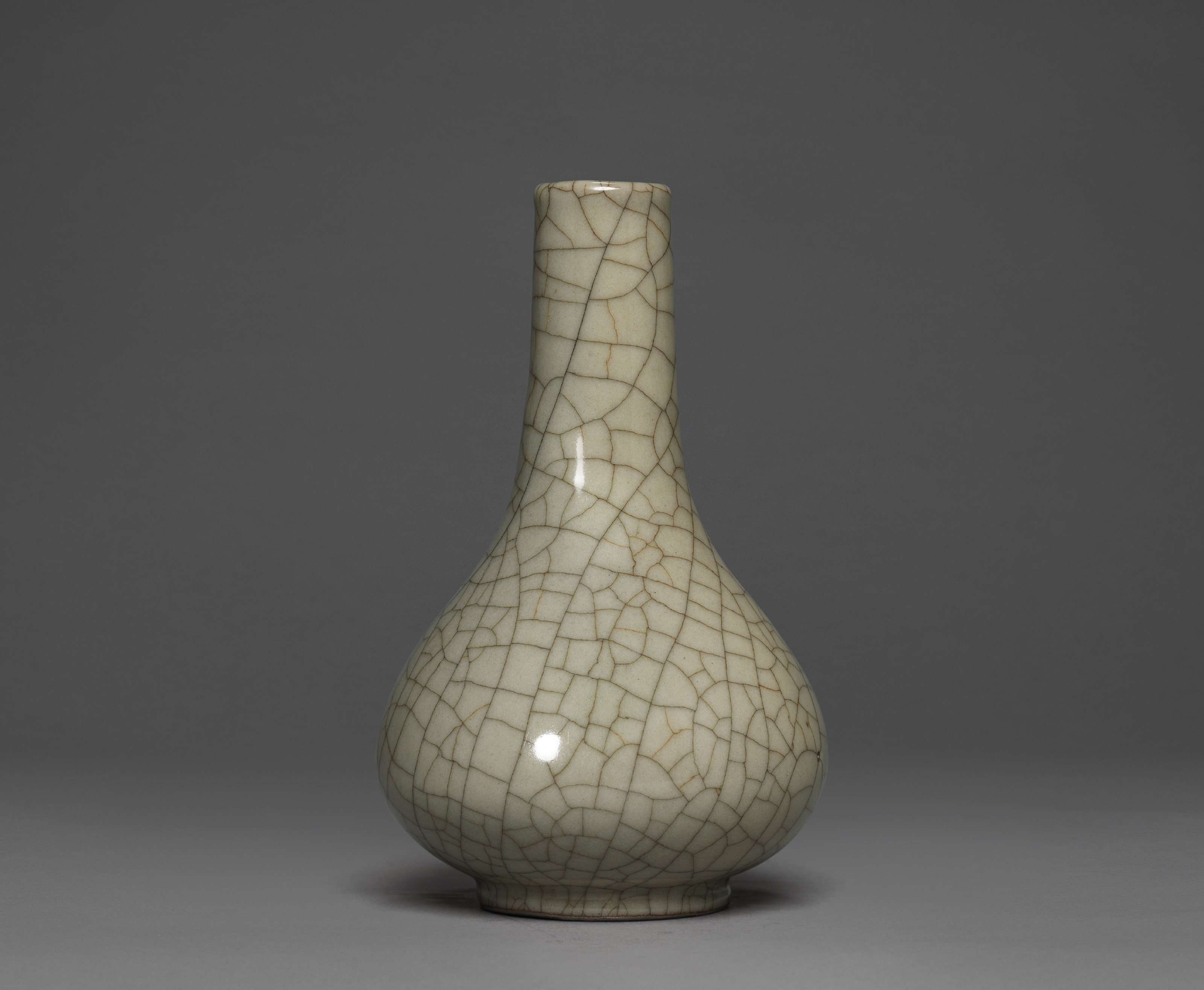
成交總額
HKD 1,180,000
估價
HKD 400,000 – HKD 500,000
A FINE AND RARE SMALL GE BOTTLE VASE
MING DYNASTY (1368-1644)
The vase is well potted with a compressed body raised on a short cylindrical foot ring and tapers to a long neck terminating in a small slightly lipped mouth.
5 1/2 in. (14 cm.) high, Japanese wood box
参考:纽约大都会博物馆 清 康熙 仿哥窑瓶Bottle
China

Object Details
Period:Qing dynasty (1644–1911), Kangxi period (1662–1722)
Culture:China
Medium:Porcelain
Dimensions:H. 6 in. (15.2 cm)
Classification:Ceramics
Credit Line:Bequest of Benjamin Altman, 1913
Accession Number:14.40.243
Signatures, Inscriptions, and Markings
Marking: None
Provenance
Benjamin Altman , New York (until d. 1913; bequeathed to MMA)
Timeline of Art History
Timelines
Central and North Asia, 1600-1800 A.D.
China, 1600-1800 A.D.
参考:纽约大都会博物馆 清 康熙 仿哥窑 Jar
China

Period:Qing dynasty (1644–1911), Kangxi period (1662–1722)
Culture:China
Medium:Porcelain (dense)
Dimensions:H. 6 3/4 in. (17.1 cm)
Classification:Ceramics
Credit Line:Bequest of Benjamin Altman, 1913
Accession Number:14.40.355
Signatures, Inscriptions, and Markings
Marking: None
Provenance
Benjamin Altman , New York (until d. 1913; bequeathed to MMA)
Timeline of Art History
Timelines
Central and North Asia, 1600-1800 A.D.
China, 1600-1800 A.D.
参考:纽约大都会博物馆 清 康熙 仿哥窑 梅瓶 Vase

China
Object Details
Period:Qing dynasty (1644–1911), Kangxi period (1662–1722)
Culture:China
Medium:Porcelain
Dimensions:H. 6 1/2 in. (16.5 cm)
Classification:Ceramics
Credit Line:Bequest of Benjamin Altman, 1913
Accession Number:14.40.244
Signatures, Inscriptions, and Markings
Marking: None
Provenance
Benjamin Altman , New York (until d. 1913; bequeathed to MMA)
Timeline of Art History
Timelines
Central and North Asia, 1600-1800 A.D.
China, 1600-1800 A.D.
参考:纽约大都会博物馆 清 仿哥窑梅瓶Prunus Vase

China
Prunus Vase, Porcelain, China
Object Details
Period:Qing dynasty (1644–1911), Kangxi period (1622–1722)
Culture:China
Medium:Porcelain
Dimensions:H. 7 1/4 in. (18.4 cm); W. 4 in. (10.2 cm); Diam. of rim: 1 3/8 in. (3.5 cm); Diam. of foot: 2 5/8 in. (6.7 cm)
Classification:Ceramics
Credit Line:Bequest of Benjamin Altman, 1913
Accession Number:14.40.5
Signatures, Inscriptions, and Markings
Marking: None
Provenance
Benjamin Altman , New York (until d. 1913; bequeathed to MMA)
Timeline of Art History
Timelines
Central and North Asia, 1600-1800 A.D.
China, 1600-1800 A.D.
参考:纽约大都会博物馆 清 仿哥窑梅瓶 Prunus Vase
China

Object Details
Period:Qing dynasty (1644–1911), Kangxi period (1622–1722)
Culture:China
Medium:Porcelain
Dimensions:H. 3 1/4 in. (8.3 cm); 2 in. (5.1 cm); Diam. of rim: 11/16 in. (1.7 cm); Diam. of foot: 1 1/4 in. (3.2 cm)
Classification:Ceramics
Credit Line:Bequest of Benjamin Altman, 1913
Accession Number:14.40.7
Signatures, Inscriptions, and Markings
Marking: None
Provenance
Benjamin Altman , New York (until d. 1913; bequeathed to MMA)
Timeline of Art History
Timelines
Central and North Asia, 1600-1800 A.D.
China, 1600-1800 A.D.
参考:纽约大都会博物馆 清 仿哥窑花瓶 Vase
China

Object Details
Period:Qing dynasty (1644–1911), Kangxi period (1662–1722)
Culture:China
Medium:Porcelain
Dimensions:H. 5 1/4 in. (13.3 cm)
Classification:Ceramics
Credit Line:Bequest of Benjamin Altman, 1913
Accession Number:14.40.256
Signatures, Inscriptions, and Markings
Marking: None
Provenance
Benjamin Altman , New York (until d. 1913; bequeathed to MMA)
Timeline of Art History
Timelines
Central and North Asia, 1600-1800 A.D.
China, 1600-1800 A.D.
参考:纽约大都会博物馆 清 仿哥窑荸荠瓶 Bottle

China
Object Details
Period:Qing dynasty (1644–1911), Kangxi period (1662–1722)
Culture:China
Medium:Porcelain
Dimensions:H. 7 1/4 in. (18.4 cm)
Classification:Ceramics
Credit Line:Bequest of Benjamin Altman, 1913
Accession Number:14.40.246
Signatures, Inscriptions, and Markings
Marking: None
Provenance
Benjamin Altman , New York (until d. 1913; bequeathed to MMA)
Timeline of Art History
Timelines
Central and North Asia, 1600-1800 A.D.
China, 1600-1800 A.D.
参考:纽约大都会博物馆 清 仿哥窑葫芦瓶 Vase

China
Object Details
Period:Qing dynasty (1644–1911), Kangxi period (1662–1722)
Culture:China
Medium:Porcelain
Dimensions:H. 7 1/4 in. (18.4 cm)
Classification:Ceramics
Credit Line:Bequest of Benjamin Altman, 1913
Accession Number:14.40.341
Signatures, Inscriptions, and Markings
Marking: None
Provenance
Benjamin Altman , New York (until d. 1913; bequeathed to MMA)
Timeline of Art History
Timelines
Central and North Asia, 1600-1800 A.D.
China, 1600-1800 A.D.
参考:纽约大都会博物馆 清 仿哥窑梅瓶 Gallipot
China

Object Details
Period:Qing dynasty (1644–1911), Kangxi period (1662–1722)
Culture:China
Medium:Porcelain with apple-green underglaze on exterior and white glaze on inner neck; clear overglaze
Dimensions:H. 7 3/4 in. (19.7 cm); Diam. 4 1/4 in. (10.8 cm)
Classification:Ceramics
Credit Line:Alfred W. Hoyt Collection, Bequest of Rosina H. Hoppin, 1965
Accession Number:65.86.36
Provenance
Alfred W. Hoyt , New York (until d. 1911); Rosina H. Hoppin , New York (until d. 1965; bequeathed to MMA)
Timeline of Art History
Timelines
Central and North Asia, 1600-1800 A.D.
China, 1600-1800 A.D.
参考:纽约大都会博物馆 清 仿哥窑梅瓶Vase
China

Object Details
Period:Qing dynasty (1644–1911), Kangxi period (1662–1722)
Culture:China
Medium:Porcelain
Dimensions:H. 5 3/4 in. (14.6 cm)
Classification:Ceramics
Credit Line:Bequest of Benjamin Altman, 1913
Accession Number:14.40.245
Signatures, Inscriptions, and Markings
Provenance
Benjamin Altman , New York (until d. 1913; bequeathed to MMA)
Timeline of Art History
Timelines
Central and North Asia, 1600-1800 A.D.
China, 1600-1800 A.D.
参考:纽约大都会博物馆 清 仿哥窑 莲子罐 Jar
China

Object Details
Period:Qing dynasty (1644–1911), Kangxi period (1662–1722)
Culture:China
Medium:Porcelain
Dimensions:H. 4 1/2 in. (11.4 cm)
Classification:Ceramics
Credit Line:Bequest of Benjamin Altman, 1913
Accession Number:14.40.342
Signatures, Inscriptions, and Markings
Marking: None
Provenance
Benjamin Altman , New York (until d. 1913; bequeathed to MMA)
Timeline of Art History
Timelines
Central and North Asia, 1600-1800 A.D.
China, 1600-1800 A.D.

![[临渊阁]天地一家春](https://www.antiquekeeper.ca/wp-content/uploads/2023/03/cropped-Asian-Art-Wallpaper-Painting3-6-2.jpg)
